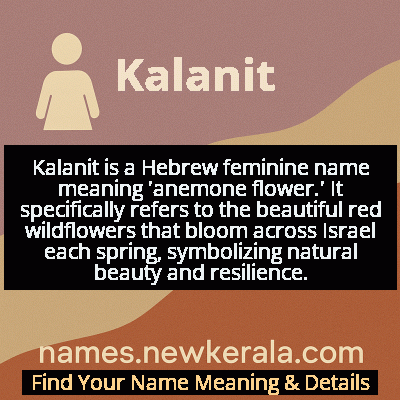Kalanit Name Meaning & Details
Origin, Popularity, Numerology Analysis & Name Meaning of Kalanit
Discover the origin, meaning, and cultural significance of the name KALANIT. Delve into its historical roots and explore the lasting impact it has had on communities and traditions.
Name
Kalanit
Gender
Female
Origin
Hebrew
Lucky Number
5
Meaning of the Name - Kalanit
Kalanit is a Hebrew feminine name meaning 'anemone flower.' It specifically refers to the beautiful red wildflowers that bloom across Israel each spring, symbolizing natural beauty and resilience.
Kalanit - Complete Numerology Analysis
Your Numerology Number
Based on Pythagorean Numerology System
Ruling Planet
Mercury
Positive Nature
Adventurous, dynamic, curious, and social.
Negative Traits
Restless, impatient, inconsistent, prone to indulgence.
Lucky Colours
Green, white.
Lucky Days
Wednesday.
Lucky Stones
Emerald.
Harmony Numbers
1, 3, 9.
Best Suited Professions
Sales, marketing, travel, entertainment.
What People Like About You
Versatility, charisma, adventurous spirit.
Famous People Named Kalanit
Kalanit Zilberman
Botanist and Researcher
Leading researcher in Israeli wildflower conservation and author of several botanical studies on native flora
Kalanit Ben-Ari
Psychologist and Author
Renowned family therapist and writer of bestselling books on relationships and parenting in modern Israeli society
Kalanit Goren
Environmental Activist
Founder of ecological preservation initiatives focusing on protecting Israel's native flower habitats
Kalanit Shapira
Educator
Pioneer in innovative educational methods and recipient of the Israeli National Education Award
Name Variations & International Equivalents
Click on blue names to explore their detailed meanings. Gray names with will be available soon.
Cultural & Historical Significance
The name gained popularity during the early years of the State of Israel as part of the 'Sabra' naming tradition, where children were given names connected to the local landscape and flora. This practice reflected the Zionist ideal of reconnecting with the land and establishing a new Israeli identity rooted in the local environment. Today, Kalanit remains a distinctly Israeli name that evokes national pride, connection to nature, and the celebration of seasonal cycles that mark life in the region. The annual 'Darom Adom' (Red South) festival celebrating the anemone bloom has further cemented the flower's cultural importance, making Kalanit a name that carries both natural beauty and national symbolism.
Extended Personality Analysis
Women named Kalanit are often perceived as vibrant, resilient, and deeply connected to their roots and natural surroundings. They typically exhibit a combination of delicate sensitivity and remarkable strength, much like the flower they're named after that thrives in challenging environments. Kalanits are often described as having a warm, engaging presence that draws people to them, with an innate ability to bring beauty and color into any situation. Their emotional intelligence and intuitive understanding of others make them excellent friends and confidantes.
These individuals tend to be creative, community-oriented, and family-focused, with strong values and a deep appreciation for life's natural rhythms. They demonstrate remarkable adaptability and perseverance when facing challenges, showing grace under pressure that inspires those around them. Kalanits are frequently seen as nurturing figures who value authenticity and have a profound understanding of the cyclical nature of life - embracing both growth and necessary endings with wisdom and grace. Their personality often reflects the flower's complete symbolism - appearing delicate but possessing inner strength, capable of flourishing in various conditions while maintaining their essential beauty and character.
Modern Usage & Popularity
Kalanit maintains a consistent but moderate presence in contemporary Israeli naming practices, particularly appealing to families who value nature-inspired names and cultural heritage. While it never reached the overwhelming popularity of biblical names like Sarah or Rachel, it occupies a special niche as a distinctly modern Hebrew name that connects children to the Israeli landscape. The name has experienced a slight resurgence in recent years, coinciding with increased environmental awareness and a 'back to nature' movement in Israeli society. Outside Israel, Kalanit remains quite rare but is occasionally chosen by Jewish families in the diaspora who wish to maintain a strong connection to Israeli culture and natural symbolism. The name is considered both contemporary and timeless, offering parents a option that is authentically Hebrew without being overtly religious, making it particularly popular in secular and traditional Jewish communities.
Symbolic & Spiritual Meanings
Kalanit carries profound symbolic meanings that extend beyond its literal translation as 'anemone flower.' It represents the beautiful paradox of resilience and delicacy - the ability to thrive in challenging conditions while maintaining graceful beauty. The vibrant red blossoms symbolize passionate vitality, life force, and the courage to stand out boldly in one's environment. As a herald of spring, the name embodies themes of renewal, hope, and the promise that follows periods of difficulty or dormancy. The flower's cyclical nature - blooming spectacularly then retreating - teaches the wisdom of natural rhythms and the importance of both expression and rest. In broader cultural context, Kalanit symbolizes the deep, unbreakable connection between people and their native land, serving as a living emblem of how beauty and strength can emerge from seemingly inhospitable conditions, making it a powerful metaphor for personal growth and cultural endurance.

